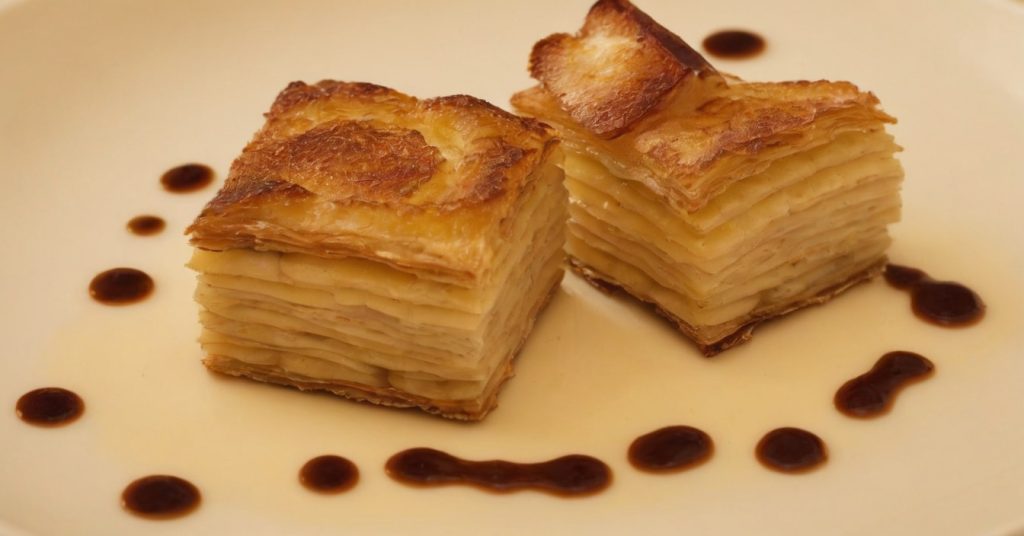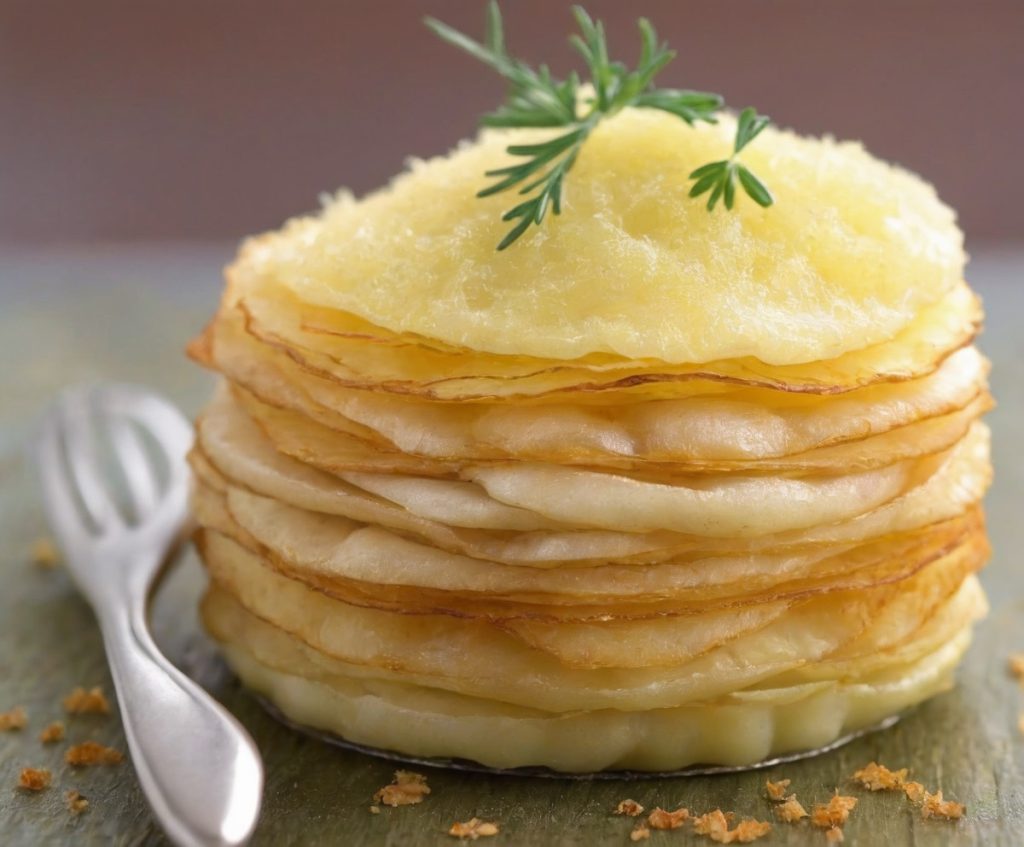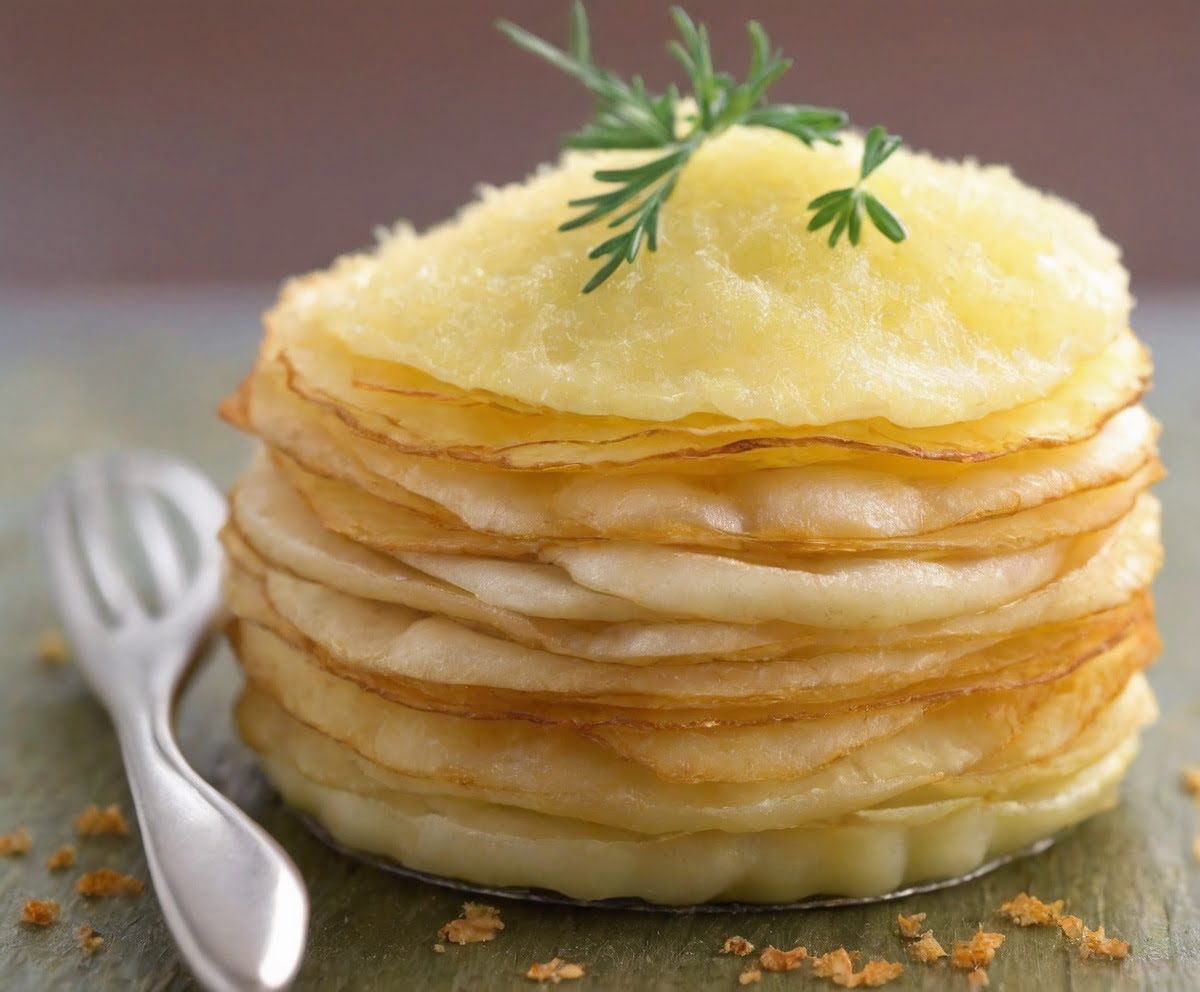Diving into the world of culinary delights, there’s a dish that stands tall, blending simplicity with elegance – the potato mille feuille. A testament to the adage “less is more,” this dish transforms the humble potato into a work of art, layer upon layer. Originating from the classic French pastry, mille feuille, which means “a thousand leaves,” the potato version swaps puff pastry for thinly sliced potatoes, resulting in a dish that’s both rustic and refined. Now, let’s peel back the layers of this culinary marvel, from its roots to the plate, ensuring every bite tells a story of flavor, texture, and tradition.
Introduction to Potato Mille Feuille

Overview of Potato Mille Feuille
The journey of the potato mille feuille begins with its name, evoking images of delicate layers, each contributing to the final masterpiece. Unlike its pastry counterpart, laden with cream and sweetness, the potato version celebrates the earthy, comforting essence of potatoes. It’s a dish that has danced through kitchens worldwide, each chef adding a personal touch, be it through the type of potato, the choice of herbs, or the accompanying sauce.
The art of creating this dish lies not just in its taste but in its presentation and texture. Imagine layers so thin and precise, they whisper of craftsmanship and patience. It’s a dish that commands attention, making it a showstopper at any table.
Mastering the Layers: The Craft Behind Potato Mille Feuille
At the heart of the potato mille feuille is the technique – the meticulous layering of potato slices, each seasoned to perfection, then baked until they achieve that golden hue and crisp edge, while remaining tender and succulent inside. This delicate balance is what sets it apart.
But, how does it differ from other layered potato dishes, you might wonder? Well, it’s all in the details. Each slice is a testament to precision, and the layering is not just about stacking but about creating harmony in flavors and textures.
In essence, the potato mille feuille is more than just a dish; it’s a celebration of the potato, elevated through simplicity and skill. As we delve deeper into its preparation, ingredients, and variations, keep in mind that this dish is a canvas, awaiting your personal touch. So, let’s embark on this culinary journey, layer by layer, savoring the beauty of simplicity and the joy of cooking.
Exploring the art of layering in dishes like our potato mille feuille shares a kinship with the techniques used in sweet pastries, such as the detailed craftsmanship seen in the Croissant Bread Loaf, where flaky layers create buttery perfection.
Ingredients and Preparation
Selecting the Right Potatoes
Choosing the right potatoes is the cornerstone of crafting an exquisite potato mille feuille. The ideal candidate? The Yukon Gold. Its buttery texture and medium starch content make it a superstar, holding its shape while baking, yet yielding that coveted, creamy interior. But don’t let that limit your creativity! The King Edward potato, with its fluffy texture, also makes a splendid choice, especially if you’re after a lighter, more delicate version.
Remember, the potato is the star here. Its variety not only influences the dish’s texture but also its flavor. So, pick wisely, and don’t shy away from experimenting with different types to find your perfect match.
Essential Ingredients for a Perfect Dish
With the potatoes selected, it’s time to gather the rest of your troupe. Clarified butter is your next key player, bringing richness and aiding in achieving that golden, crispy exterior. A dash of coarse kosher salt and a sprinkle of black pepper are all you need to elevate the potatoes’ natural flavors.
But why stop there? Let’s invite herbs to the party. A hint of rosemary or sage can transport your potato mille feuille to new heights, adding a whisper of the Mediterranean to each bite. And for those who tread the path less taken, a drizzle of truffle oil or a garnish of fresh chives can add an unexpected twist.
The beauty of this dish lies in its simplicity, allowing each ingredient to shine. So, choose with care, and prepare to layer not just potatoes, but a tapestry of flavors.
In the next part, we’ll dive into the heart of the matter – the layering and baking process. This is where your potato mille feuille comes to life, transforming simple ingredients into a symphony of textures and tastes. So, sharpen your knives and preheat your ovens; we’re about to embark on the most thrilling part of our culinary journey.
For those looking to adapt our potato mille feuille to fit a plant-based diet, take inspiration from our guide on creating a delightful Vegan Almond Croissant, which explores plant-based alternatives that can enrich your culinary endeavors.
Step-by-Step Cooking Guide
Preparing the Potatoes
First things first, let’s prep our potatoes. Begin by giving them a good wash – we’re talking about a thorough scrubbing here, as we want our potatoes as clean as a whistle. Next up, peeling. While some might argue for keeping the skins on for that rustic feel, peeling them off gives our potato mille feuille that classic, sophisticated look we’re aiming for.
Now, the slicing – arguably the most crucial step. You’ll want to get these slices as thin as a whisper, uniform in thickness to ensure even cooking. A mandoline slicer is your best friend here, but a sharp knife and a steady hand can do the trick too. Remember, patience is key; rush through this, and you’ll end up with a potato mille feuille that’s more rustic than refined.
Layering and Seasoning
With our potato slices ready, it’s time to layer. Think of it as building a house, where each slice is a brick, and the clarified butter is your mortar. Start with a layer of potato slices at the bottom of your baking dish, slightly overlapping each other like shingles on a roof. Now, brush on a generous amount of clarified butter – this not only adds flavor but also helps in achieving that golden, crispy top layer we all love.
Sprinkle a dash of salt and pepper, and if you’re feeling adventurous, a hint of your chosen herbs. Repeat these steps, building up your layers until you run out of potato slices. The key here is consistency – keep your layers uniform to ensure an even bake.
Baking to Perfection
It’s showtime! Slide your assembled potato mille feuille into a preheated oven and let the magic happen. This isn’t a dish to rush; low and slow is the mantra, allowing the potatoes to cook through, becoming tender inside, with a crisp, golden top that’s music to the ears.
Keep an eye on it, though. All ovens are a bit different, and you wouldn’t want your masterpiece to turn from golden to burnt. A skewer or a knife should slide in with no resistance when it’s done, signaling that your potato mille feuille is ready to take center stage on your dining table.
In our next segment, we’ll talk about turning this beautifully baked creation into a culinary spectacle, with cutting techniques and presentation tips that’ll make your potato mille feuille the talk of the town. So, stay tuned, and keep those oven mitts handy!
Serving and Presenting Your Potato Mille Feuille

Cutting and Plating Techniques
Our potato mille feuille has emerged from the oven, a golden masterpiece of layered perfection. Now, the moment of truth – cutting into this beauty. The key here is to let it cool just enough to set, making the layers more cohesive and easier to slice through. Using a sharp knife, cut into squares or rectangles, depending on your preference. Each piece should showcase the layers distinctly, a testament to your culinary prowess.
Plating is where your creativity can shine. Whether you’re aiming for rustic charm or elegant sophistication, the presentation should complement the dish’s character. For a casual family dinner, consider serving it directly from the baking dish, inviting everyone to dig in and experience the communal joy of shared meals. For a more formal affair, individual portions plated with precision, adorned with a sprig of fresh herbs, can elevate the potato mille feuille to a dish worthy of the finest dining table.
Sauce and Garnish Recommendations
While our potato mille feuille can stand proud on its own, a well-chosen sauce or garnish can enhance its flavors and add a visual pop. A dollop of sour cream or a drizzle of homemade garlic aioli can add a creamy, tangy contrast to the crispy potatoes, while a sprinkling of fresh chives or parsley can bring a burst of color and freshness.
For those seeking an extra layer of flavor, consider a light, herby sauce that complements the dish without overpowering it. A basil pesto or a sage brown butter sauce can tie all the elements together, creating a harmonious plate that delights the senses.
In essence, the final presentation of your potato mille feuille is not just about feeding the body but also the soul. It’s an opportunity to turn a simple meal into a memorable experience, where each bite tells a story of care, craftsmanship, and culinary adventure.
As we move forward, we’ll delve into the FAQs, addressing common queries and shedding light on the nuances that make this dish a beloved classic. Whether you’re a seasoned chef or a culinary novice, there’s always more to learn, more to explore, and more to savor.
Advanced Tips and Variations
Experimenting with Flavors and Ingredients
Once you’ve mastered the classic potato mille feuille, why not spice things up a bit? The dish’s simplicity makes it a perfect canvas for culinary creativity. Consider infusing the clarified butter with herbs like rosemary or thyme for an aromatic twist. Or, layer in some thinly sliced onions or leeks between the potato layers for a subtle sweetness that complements the earthy potatoes.
For those with a daring palate, incorporating different root vegetables such as sweet potatoes or parsnips can add a vibrant color contrast and a nuanced flavor profile. Just ensure that all components are sliced uniformly to maintain the dish’s elegant structure.
Vegetarian and Vegan Adaptations
Catering to dietary preferences shouldn’t mean compromising on taste or presentation. For a vegan version of the potato mille feuille, swap out the clarified butter for a high-quality olive oil or a vegan butter alternative. This not only keeps the dish dairy-free but also introduces a new dimension of flavor.
Additionally, experimenting with vegan cheese alternatives between layers can add a creamy, indulgent element without straying from dietary restrictions. The key is to find a vegan cheese that melts well and complements the natural flavors of the potatoes and herbs.
Embracing these variations and advanced tips not only keeps your culinary repertoire fresh but also showcases the versatility of the humble potato. Whether you’re sticking to the classic or venturing into new flavor territories, the potato mille feuille is a testament to the beauty of simplicity in cooking, where a few well-chosen ingredients, prepared with care and creativity, can result in a dish that’s truly greater than the sum of its parts.
FAQs
Difference Between Potato Pave and Dauphinoise
A common conundrum in the culinary world is distinguishing between potato pavé and dauphinoise. Both are beloved for their layered potato goodness, but they’re not quite the same. Potato pavé, often likened to our potato mille feuille, is known for its precise, uniform layers, compact structure, and often, a crispier exterior. On the other hand, dauphinoise leans towards a creamier, more indulgent experience, with cream and garlic playing pivotal roles, and the layers being a tad more relaxed in their arrangement.
Best Practices for Baking Large Quantities
When it comes to baking large quantities of potato mille feuille, the key is in the preparation. Ensure all your potatoes are sliced uniformly to promote even cooking. Consider using multiple dishes if necessary, as overcrowding can lead to uneven baking. Also, rotating the dishes halfway through the baking process can help achieve that perfect golden crust on every piece.
Common Mistakes and How to Avoid Them
Even the most seasoned chefs can encounter pitfalls when crafting a potato mille feuille. One common mistake is not slicing the potatoes thinly enough, resulting in a texture that’s more chunky than delicate. Another is skimping on the seasoning between layers, which can leave the dish tasting flat. To avoid these, always use a mandoline slicer for consistent thin slices and don’t forget to season every layer gently but confidently.
In the next segment, we’ll explore advanced tips and variations to keep your potato mille feuille exciting and new, each time you make it. Whether you’re sticking to tradition or venturing into uncharted culinary territories, there’s always room for a twist in this classic dish.

